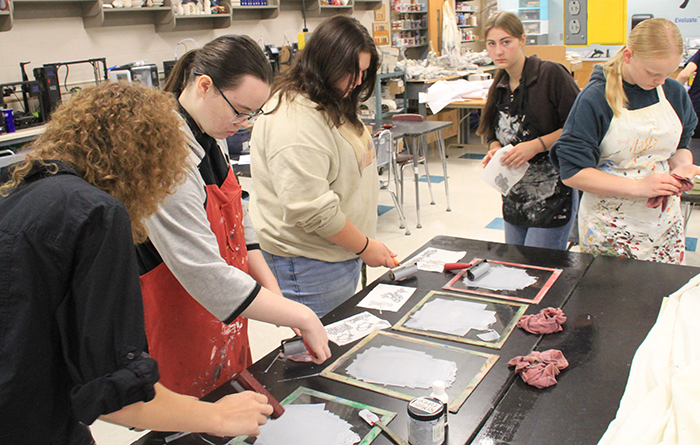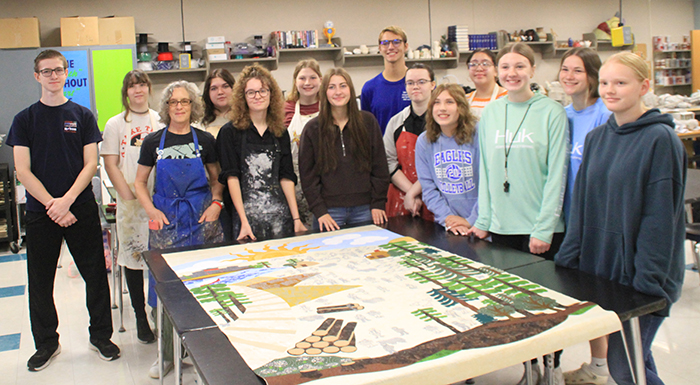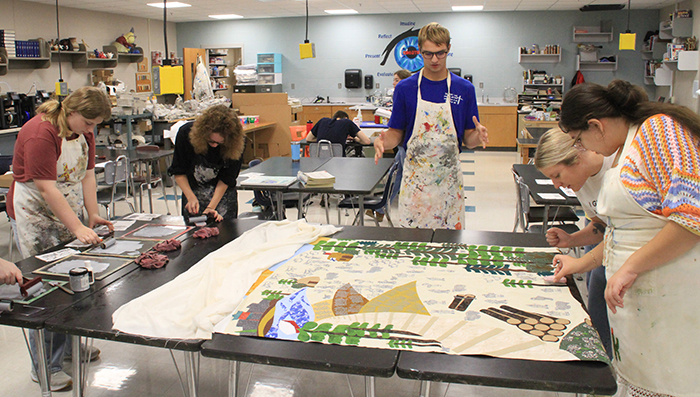Artist in residence creates NYM mural
News | Published on October 7, 2025 at 3:26pm GMT+0000 | Author: Tucker Henderson
0Historically-based mural will be displayed at NYM School

Jill Levene was September’s visiting artist at the Cultural Center and worked with art students at the school to construct a historically-based mural of New York Mills. The mural will be displayed at the Cultural Center for a short time and then will move on to a more permanent location at the school.
By Tucker Henderson
Reporter
Retired graphic designer, Jill Levene, of Warren, Minn. was September’s Artist in Residence through the New York Mills Regional Cultural Center and she “steeped in the culture” of the town throughout her time here.
Levene’s proposed project was a printmaking project, which included a fabric mural with handmade stamped ink images inspired by the history of the area. With three weeks to do just that, she did her homework on history, collaborated with the school and immersed herself in the town of NY Mills.

Jill Levene was September’s visiting artist at the Cultural Center and worked with art students at the school to construct a historically-based mural of New York Mills. The mural will be displayed at the Cultural Center for a short time and then will move on to a more permanent location at the school.
“I became a member of the Otter Tail County Historical Society and went to Fergus Falls to use their library,” said Levene. “I did a lot of research, did a lot of reading. I had some books from the library and did a lot of internet searching, all those sorts of things.

“I built a fabric mural and we attached fabric materials to it—they’re iron on heat-and-bond materials—all the elements, the railroad track, and trees, and the sky. I had the high school students carve all the characters—the homesteaders, the lumberjacks, the indigenous people, the cows, sheep, wheat, cucumbers, potato plants—so they printed them on the mural to finish the story,” she continued.
In collaboration with Tammy Olson’s art class, Levene taught the high school students how to carve rubber stamps, ink and print with them, and how to set up the scenes on the mural last week. With aprons and stamps, they created a scene of early life in the town of NY Mills, when homesteaders and Native Americans shared gifts and crops and trees abounded.
“I often work with much younger students, so this was really delightful, they are incredibly talented,” said Levene. “They just did a fantastic job! I have done a mural project similar to this near where I live and it was quite successful, so that’s what I decided I was going to do for my project here in New York Mills.”
Leven’s interest in printmaking came from a trip to the Boston, Mass. area and learning about the Folly Cove Designers, a group of primarily-women artists who used old linoleum floor tiles for making prints on dishtowels, aprons, curtains, table runners, napkins, clothing and many other designs.
“I had done printmaking in college as part of my curriculum and I really enjoyed it, but didn’t do a lot of it after college,” said Levene. “When I discovered these Folly Cove Designer ladies, it really just sparked something and I was like, ‘oh, yeah, printmaking, that looks like a lot of fun.’
“I primarily print fabric, I sell a lot of my work in a few shops in Minnesota and Illinois and that’s kind of my bread and butter,” she continued. “I do some teaching near where I live, Art in the Park, and some different events that I coordinate. I just did a whole week-long session with the summer reading program where I live and we made art everyday and everyday was a different age group of kids, so that was really fun.”
The historically-based mural of New York Mills will be displayed at the Cultural Center for a short time and then will move on to a more permanent location at the school. Levene said she made the best of her time in town with the distraction-free environment of the residence house.
“It’s been really a wonderful experience and staying in the retreat house has been this total immersion,” she said. “When you have this total immersion where there’s almost no outside distractions, it’s amazing what you can accomplish. I don’t have to worry about all those things that distract you at home. It felt very comfortable and very inspiring, it’s a really great working space for my work.”
Another part of living and working in a quieter, slower-paced environment is the ability to take in the scenery and find a deeper understanding of the area you’re in. Without a vehicle to drive around in, she was able to take to the sidewalks with a slower, more flexible method of travel.
“I don’t have a car here, so I’ve had my bike,” she said. “I have been able to slowly and gently explore town on my bike, which is like walking, you don’t miss as much. When you’re in a car, you miss a lot. On a bike, you can stop and I can check things out, so I’ve tried to bike all over town to really just explore everything and visit a lot of the businesses. I went to the Farmers Market two different Saturdays in a row and visited with some interesting locals.
“When you’re fully immersed in a project and all those things that make a town unique and special, I think people miss out if they don’t get away from whatever project they’re working on and get out and explore the area,” she continued. “It helps you learn more and maybe put more of that culture into your artwork. I think the more you know, the better you can represent the town if that’s what you’re doing in your artwork. It’s been a lot of fun being here, I’ve really enjoyed it.”
